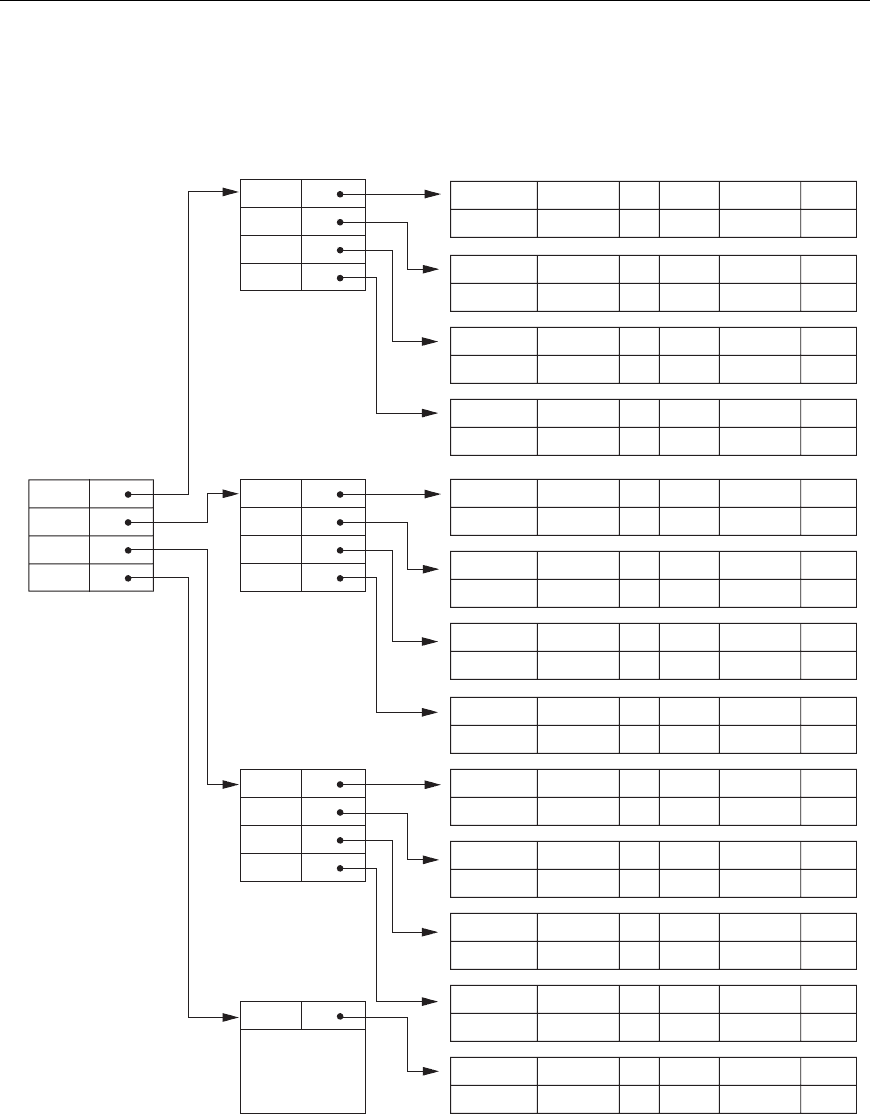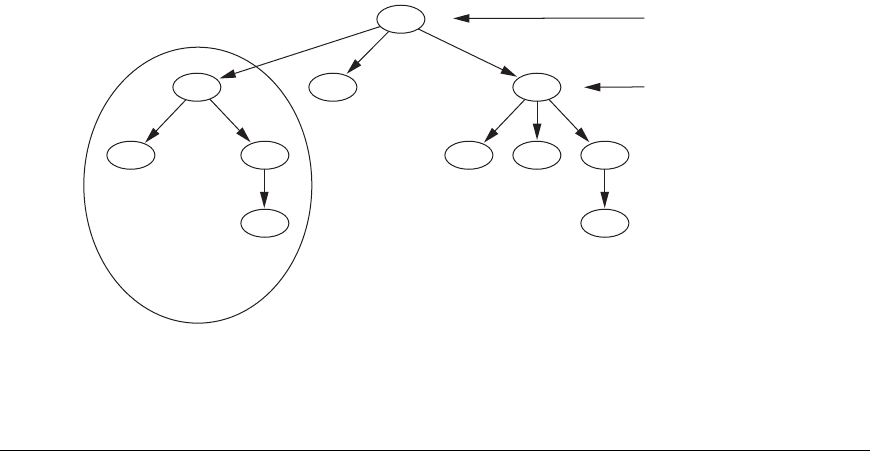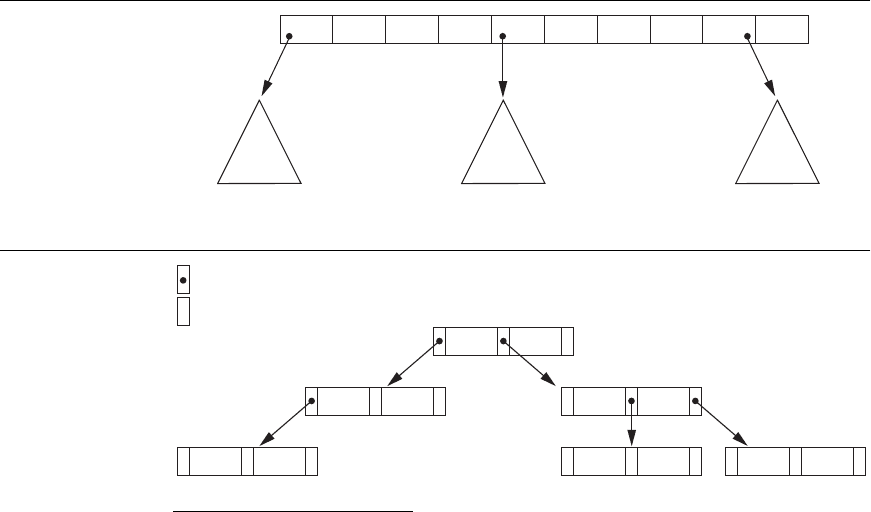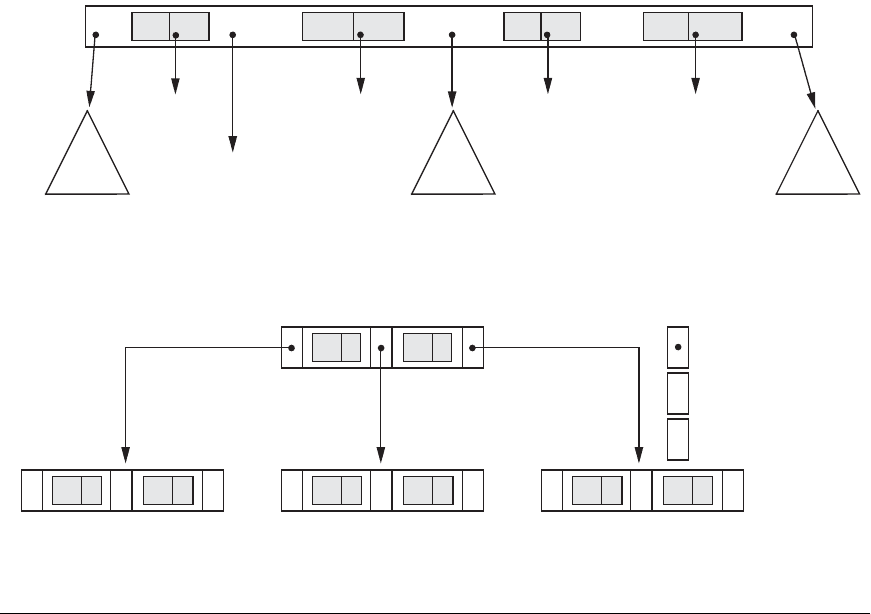Elmasri R., Navathe S.B. Fundamentals of Database Systems
Подождите немного. Документ загружается.


642 Chapter 18 Indexing Structures for Files
Notice that a secondary index provides a logical ordering on the records by the
indexing field. If we access the records in order of the entries in the secondary index,
we get them in order of the indexing field. The primary and clustering indexes
assume that the field used for physical ordering of records in the file is the same as
the indexing field.
18.1.4 Summary
To conclude this section, we summarize the discussion of index types in two tables.
Table 18.1 shows the index field characteristics of each type of ordered single-level
index discussed—primary, clustering, and secondary. Table 18.2 summarizes the
properties of each type of index by comparing the number of index entries and
specifying which indexes are dense and which use block anchors of the data file.
Table 18.1 Types of Indexes Based on the Properties of the Indexing Field
Index Field Used
for Physical Ordering
of the File
Index Field Not Used
for Physical Ordering
of the File
Indexing field is key Primary index Secondary index (Key)
Indexing field is nonkey Clustering index Secondary index (NonKey)
Table 18.2 Properties of Index Types
Type of Index
Number of (First-level)
Index Entries
Dense or Nondense
(Sparse)
Block Anchoring
on the Data File
Primary Number of blocks in
data file
Nondense Ye s
Clustering Number of distinct
index field values
Nondense
Yes/no
a
Secondary (key) Number of records in
data file
Dense No
Secondary (nonkey)
Number of records
b
or
number of distinct index
field values
c
Dense or Nondense No
a
Yes if every distinct value of the ordering field starts a new block; no otherwise.
b
For option 1.
c
For options 2 and 3.

18.2 Multilevel Indexes 643
18.2 Multilevel Indexes
The indexing schemes we have described thus far involve an ordered index file. A
binary search is applied to the index to locate pointers to a disk block or to a record
(or records) in the file having a specific index field value. A binary search requires
approximately (log
2
b
i
) block accesses for an index with b
i
blocks because each step
of the algorithm reduces the part of the index file that we continue to search by a
factor of 2. This is why we take the log function to the base 2. The idea behind a
multilevel index is to reduce the part of the index that we continue to search by bfr
i
,
the blocking factor for the index, which is larger than 2. Hence, the search space is
reduced much faster. The value bfr
i
is called the fan-out of the multilevel index, and
we will refer to it by the symbol fo. Whereas we divide the record search space into
two halves at each step during a binary search, we divide it n-ways (where n = the
fan-out) at each search step using the multilevel index. Searching a multilevel index
requires approximately (log
fo
b
i
) block accesses, which is a substantially smaller
number than for a binary search if the fan-out is larger than 2. In most cases, the
fan-out is much larger than 2.
A multilevel index considers the index file, which we will now refer to as the first (or
base) level of a multilevel index, as an ordered file with a distinct value for each K(i).
Therefore, by considering the first-level index file as a sorted data file, we can create
a primary index for the first level; this index to the first level is called the second
level of the multilevel index. Because the second level is a primary index, we can use
block anchors so that the second level has one entry for each block of the first level.
The blocking factor bfr
i
for the second level—and for all subsequent levels—is the
same as that for the first-level index because all index entries are the same size; each
has one field value and one block address. If the first level has r
1
entries, and the
blocking factor—which is also the fan-out—for the index is bfr
i
= fo, then the first
level needs ⎡(r
1
/fo)⎤ blocks, which is therefore the number of entries r
2
needed at the
second level of the index.
We can repeat this process for the second level. The third level, which is a primary
index for the second level, has an entry for each second-level block, so the number
of third-level entries is r
3
= ⎡(r
2
/fo)⎤. Notice that we require a second level only if the
first level needs more than one block of disk storage, and, similarly, we require a
third level only if the second level needs more than one block. We can repeat the
preceding process until all the entries of some index level t fit in a single block. This
block at the tth level is called the top index level.
4
Each level reduces the number of
entries at the previous level by a factor of fo—the index fan-out—so we can use the
formula 1 ≤ (r
1
/((fo)
t
)) to calculate t. Hence, a multilevel index with r
1
first-level
entries will have approximately t levels, where t = ⎡(log
fo
(r
1
))⎤. When searching the
4
The numbering scheme for index levels used here is the reverse of the way levels are commonly
defined for tree data structures. In tree data structures, t is referred to as level 0 (zero), t – 1 is level 1,
and so on.
644 Chapter 18 Indexing Structures for Files
index, a single disk block is retrieved at each level. Hence, t disk blocks are accessed
for an index search, where t is the number of index levels.
The multilevel scheme described here can be used on any type of index—whether it
is primary, clustering, or secondary—as long as the first-level index has distinct val-
ues for K(i) and fixed-length entries. Figure 18.6 shows a multilevel index built over a
primary index. Example 3 illustrates the improvement in number of blocks accessed
when a multilevel index is used to search for a record.
Example 3. Suppose that the dense secondary index of Example 2 is converted into
a multilevel index. We calculated the index blocking factor bfr
i
= 68 index entries
per block, which is also the fan-out fo for the multilevel index; the number of first-
level blocks b
1
= 442 blocks was also calculated. The number of second-level blocks
will be b
2
= ⎡(b
1
/fo)⎤ = ⎡(442/68)⎤ = 7 blocks, and the number of third-level blocks
will be b
3
= ⎡(b
2
/fo)⎤ = ⎡(7/68)⎤ = 1 block. Hence, the third level is the top level of
the index, and t = 3. To access a record by searching the multilevel index, we must
access one block at each level plus one block from the data file, so we need t + 1 = 3
+ 1 = 4 block accesses. Compare this to Example 2, where 10 block accesses were
needed when a single-level index and binary search were used.
Notice that we could also have a multilevel primary index, which would be non-
dense. Exercise 18.18(c) illustrates this case, where we must access the data block
from the file before we can determine whether the record being searched for is in
the file. For a dense index, this can be determined by accessing the first index level
(without having to access a data block), since there is an index entry for every record
in the file.
A common file organization used in business data processing is an ordered file with
a multilevel primary index on its ordering key field. Such an organization is called
an indexed sequential file and was used in a large number of early IBM systems.
IBM’s ISAM organization incorporates a two-level index that is closely related to
the organization of the disk in terms of cylinders and tracks (see Section 17.2.1).
The first level is a cylinder index, which has the key value of an anchor record for
each cylinder of a disk pack occupied by the file and a pointer to the track index for
the cylinder. The track index has the key value of an anchor record for each track in
the cylinder and a pointer to the track. The track can then be searched sequentially
for the desired record or block. Insertion is handled by some form of overflow file
that is merged periodically with the data file. The index is recreated during file reor-
ganization.
Algorithm 18.1 outlines the search procedure for a record in a data file that uses a
nondense multilevel primary index with t levels. We refer to entry i at level j of the
index as <K
j
(i), P
j
(i)>, and we search for a record whose primary key value is K.We
assume that any overflow records are ignored. If the record is in the file, there must
be some entry at level 1 with K
1
(i) f K < K
1
(i + 1) and the record will be in the block
of the data file whose address is P
1
(i). Exercise 18.23 discusses modifying the search
algorithm for other types of indexes.

18.2 Multilevel Indexes 645
Data file
Primary
key field
Second (top)
level
Two-level index
2
5
8
12
15
21
24
29
35
36
39
41
44
46
51
52
55
58
63
66
71
78
80
82
85
89
2
35
55
85
First (base)
level
2
8
15
24
35
39
44
51
55
63
71
80
85
Figure 18.6
A two-level primary index resembling ISAM (Indexed Sequential
Access Method) organization.

646 Chapter 18 Indexing Structures for Files
Algorithm 18.1. Searching a Nondense Multilevel Primary Index with t Levels
(* We assume the index entry to be a block anchor that is the first key per block. *)
p ← address of top-level block of index;
for j ← t step – 1 to 1 do
begin
read the index block (at jth index level) whose address is p;
search block p for entry i such that K
j
(i) ≤ K < K
j
(i + 1)
(* if K
j
(i)
is the last entry in the block, it is sufficient to satisfy K
j
(i) ≤ K *);
p ← P
j
(i ) (* picks appropriate pointer at jth index level *)
end;
read the data file block whose address is p;
search block p for record with key = K;
As we have seen, a multilevel index reduces the number of blocks accessed when
searching for a record, given its indexing field value. We are still faced with the prob-
lems of dealing with index insertions and deletions, because all index levels are
physically ordered files. To retain the benefits of using multilevel indexing while
reducing index insertion and deletion problems, designers adopted a multilevel
index called a dynamic multilevel index that leaves some space in each of its blocks
for inserting new entries and uses appropriate insertion/deletion algorithms for cre-
ating and deleting new index blocks when the data file grows and shrinks. It is often
implemented by using data structures called B-trees and B
+
-trees, which we
describe in the next section.
18.3 Dynamic Multilevel Indexes Using
B-Trees and B
+
-Trees
B-trees and B
+
-trees are special cases of the well-known search data structure
known as a tree. We briefly introduce the terminology used in discussing tree data
structures. A tree is formed of nodes. Each node in the tree, except for a special
node called the root, has one parent node and zero or more child nodes. The root
node has no parent. A node that does not have any child nodes is called a leaf node;
a nonleaf node is called an internal node. The level of a node is always one more
than the level of its parent, with the level of the root node being zero.
5
A subtree of
a node consists of that node and all its descendant nodes—its child nodes, the child
nodes of its child nodes, and so on. A precise recursive definition of a subtree is that
it consists of a node n and the subtrees of all the child nodes of n. Figure 18.7 illus-
trates a tree data structure. In this figure the root node is A, and its child nodes are
B, C, and D. Nodes E, J, C, G, H, and K are leaf nodes. Since the leaf nodes are at dif-
ferent levels of the tree, this tree is called unbalanced.
5
This standard definition of the level of a tree node, which we use throughout Section 18.3, is different
from the one we gave for multilevel indexes in Section 18.2.

18.3 Dynamic Multilevel Indexes Using B-Trees and B
+
-Trees 647
A
CB
Subtree for node B
(Nodes E, J, C, G, H, and K are leaf nodes of the tree)
Root node (level 0)
Nodes at level 1
D
Nodes at level 2D
F I
Nodes at level 3I
HG
J
E
K
Figure 18.7
A tree data structure that shows an unbalanced tree.
In Section 18.3.1, we introduce search trees and then discuss B-trees, which can be
used as dynamic multilevel indexes to guide the search for records in a data file. B-
tree nodes are kept between 50 and 100 percent full, and pointers to the data blocks
are stored in both internal nodes and leaf nodes of the B-tree structure. In Section
18.3.2 we discuss B
+
-trees, a variation of B-trees in which pointers to the data blocks
of a file are stored only in leaf nodes, which can lead to fewer levels and higher-
capacity indexes. In the DBMSs prevalent in the market today, the common struc-
ture used for indexing is B
+
-trees.
18.3.1 Search Trees and B-Trees
A search tree is a special type of tree that is used to guide the search for a record,
given the value of one of the record’s fields. The multilevel indexes discussed in
Section 18.2 can be thought of as a variation of a search tree; each node in the mul-
tilevel index can have as many as fo pointers and fo key values, where fo is the index
fan-out. The index field values in each node guide us to the next node, until we
reach the data file block that contains the required records. By following a pointer,
we restrict our search at each level to a subtree of the search tree and ignore all
nodes not in this subtree.
Search Trees. A search tree is slightly different from a multilevel index. A search
tree of order p is a tree such that each node contains at most p − 1 search values and
p pointers in the order <P
1
, K
1
, P
2
, K
2
, ..., P
q−1
, K
q−1
, P
q
>, where q ≤ p.Each P
i
is a
pointer to a child node (or a
NULL pointer), and each K
i
is a search value from some

648 Chapter 18 Indexing Structures for Files
P
1
P
1
K
1
K
i–1
K
q–1
< X
X
K
i–1
< X < K
i
X
X < K
1
X
P
i
K
i
K
q–1
P
q
. . . . . .
Figure 18.8
A node in a search
tree with pointers to
subtrees below it.
5
3
Tree node pointer
Null tree pointer
69
78 121
Figure 18.9
A search tree of
order p = 3.
ordered set of values. All search values are assumed to be unique.
6
Figure 18.8 illus-
trates a node in a search tree. Two constraints must hold at all times on the search
tree:
1. Within each node, K
1
< K
2
< ... < K
q−1
.
2. For all values X in the subtree pointed at by P
i
, we have K
i−1
< X < K
i
for 1 <
i < q; X < K
i
for i = 1; and K
i−1
< X for i = q (see Figure 18.8).
Whenever we search for a value X, we follow the appropriate pointer P
i
according to
the formulas in condition 2 above. Figure 18.9 illustrates a search tree of order p = 3
and integer search values. Notice that some of the pointers P
i
in a node may be NULL
pointers.
We can use a search tree as a mechanism to search for records stored in a disk file.
The values in the tree can be the values of one of the fields of the file, called
the search field (which is the same as the index field if a multilevel index guides the
search). Each key value in the tree is associated with a pointer to the record in the
data file having that value. Alternatively, the pointer could be to the disk block con-
taining that record. The search tree itself can be stored on disk by assigning each tree
node to a disk block. When a new record is inserted in the file, we must update the
search tree by inserting an entry in the tree containing the search field value of the
new record and a pointer to the new record.
6
This restriction can be relaxed. If the index is on a nonkey field, duplicate search values may exist and
the node structure and the navigation rules for the tree may be modified.

18.3 Dynamic Multilevel Indexes Using B-Trees and B
+
-Trees 649
Algorithms are necessary for inserting and deleting search values into and from the
search tree while maintaining the preceding two constraints. In general, these algo-
rithms do not guarantee that a search tree is balanced, meaning that all of its leaf
nodes are at the same level.
7
The tree in Figure 18.7 is not balanced because it has
leaf nodes at levels 1, 2, and 3. The goals for balancing a search tree are as follows:
■
To guarantee that nodes are evenly distributed, so that the depth of the tree
is minimized for the given set of keys and that the tree does not get skewed
with some nodes being at very deep levels
■
To make the search speed uniform, so that the average time to find any ran-
dom key is roughly the same
While minimizing the number of levels in the tree is one goal, another implicit goal
is to make sure that the index tree does not need too much restructuring as records
are inserted into and deleted from the main file. Thus we want the nodes to be as full
as possible and do not want any nodes to be empty if there are too many deletions.
Record deletion may leave some nodes in the tree nearly empty, thus wasting storage
space and increasing the number of levels. The B-tree addresses both of these prob-
lems by specifying additional constraints on the search tree.
B-Trees. The B-tree has additional constraints that ensure that the tree is always
balanced and that the space wasted by deletion, if any, never becomes excessive. The
algorithms for insertion and deletion, though, become more complex in order to
maintain these constraints. Nonetheless, most insertions and deletions are simple
processes; they become complicated only under special circumstances—namely,
whenever we attempt an insertion into a node that is already full or a deletion from
a node that makes it less than half full. More formally, a B-tree of order p,when
used as an access structure on a key field to search for records in a data file, can be
defined as follows:
1. Each internal node in the B-tree (Figure 18.10(a)) is of the form
<P
1
,<K
1
, Pr
1
>, P
2
,<K
2
, Pr
2
>, ..., <K
q–1
, Pr
q–1
>, P
q
>
where q ≤ p.Each P
i
is a tree pointer—a pointer to another node in the B-
tree. Each Pr
i
is a data pointer
8
—a pointer to the record whose search key
field value is equal to K
i
(or to the data file block containing that record).
2. Within each node, K
1
< K
2
< ... < K
q−1
.
3. For all search key field values X in the subtree pointed at by P
i
(the ith sub-
tree, see Figure 18.10(a)), we have:
K
i–1
< X < K
i
for 1 < i < q; X < K
i
for i = 1; and K
i–1
< X for i = q.
4. Each node has at most p tree pointers.
7
The definition of balanced is different for binary trees. Balanced binary trees are known as AVL trees.
8
A data pointer is either a block address or a record address; the latter is essentially a block address and
a record offset within the block.

650 Chapter 18 Indexing Structures for Files
X Tree
pointer
Tree
pointer
Tree
pointer
(a)
(b)
P
2
X
Data
pointer
Data
pointer
Data
pointer
5
o
8
Tree node pointer
o
6
o
7
o
9
o
12
o
Data pointer
Null tree pointer
1
o
3
o
Data
pointer
P
1
Pr
1
K
1
K
i–1
Pr
q–1
K
q–1
X
K
q–1
< X
K
i–1
< X < K
i
X < K
1
P
i
P
q
. . . . . .
Pr
i–1
K
i
Pr
i
Tree
pointer
o
Figure 18.10
B-tree structures. (a) A node in a B-tree with q – 1 search values. (b) A B-tree
of order p = 3.The values were inserted in the order 8, 5, 1, 7, 3, 12, 9, 6.
5.
Each node, except the root and leaf nodes, has at least ⎡(p/2)⎤ tree pointers.
The root node has at least two tree pointers unless it is the only node in the
tree.
6. A node with q tree pointers, q ≤ p, has q – 1 search key field values (and hence
has q – 1 data pointers).
7. All leaf nodes are at the same level. Leaf nodes have the same structure as
internal nodes except that all of their tree pointers P
i
are NULL.
Figure 18.10(b) illustrates a B-tree of order p = 3. Notice that all search values K in
the B-tree are unique because we assumed that the tree is used as an access structure
on a key field. If we use a B-tree on a nonkey field, we must change the definition of
the file pointers Pr
i
to point to a block—or a cluster of blocks—that contain the
pointers to the file records. This extra level of indirection is similar to option 3, dis-
cussed in Section 18.1.3, for secondary indexes.
A B-tree starts with a single root node (which is also a leaf node) at level 0 (zero).
Once the root node is full with p – 1 search key values and we attempt to insert
another entry in the tree, the root node splits into two nodes at level 1. Only the
middle value is kept in the root node, and the rest of the values are split evenly

18.3 Dynamic Multilevel Indexes Using B-Trees and B
+
-Trees 651
between the other two nodes. When a nonroot node is full and a new entry is
inserted into it, that node is split into two nodes at the same level, and the middle
entry is moved to the parent node along with two pointers to the new split nodes. If
the parent node is full, it is also split. Splitting can propagate all the way to the root
node, creating a new level if the root is split. We do not discuss algorithms for B-
trees in detail in this book,
9
but we outline search and insertion procedures for
B
+
-trees in the next section.
If deletion of a value causes a node to be less than half full, it is combined with its
neighboring nodes, and this can also propagate all the way to the root. Hence, dele-
tion can reduce the number of tree levels. It has been shown by analysis and simula-
tion that, after numerous random insertions and deletions on a B-tree, the nodes
are approximately 69 percent full when the number of values in the tree stabilizes.
This is also true of B
+
-trees. If this happens, node splitting and combining will
occur only rarely, so insertion and deletion become quite efficient. If the number of
values grows, the tree will expand without a problem—although splitting of nodes
may occur, so some insertions will take more time. Each B-tree node can have at
most p tree pointers, p – 1 data pointers, and p – 1 search key field values (see Figure
18.10(a)).
In general, a B-tree node may contain additional information needed by the algo-
rithms that manipulate the tree, such as the number of entries q in the node and a
pointer to the parent node. Next, we illustrate how to calculate the number of blocks
and levels for a B-tree.
Example 4. Suppose that the search field is a nonordering key field, and we con-
struct a B-tree on this field with p = 23. Assume that each node of the B-tree is 69
percent full. Each node, on the average, will have p
*
0.69 = 23
*
0.69 or approxi-
mately 16 pointers and, hence, 15 search key field values. The average fan-out fo =
16. We can start at the root and see how many values and pointers can exist, on the
average, at each subsequent level:
Root: 1 node 15 key entries 16 pointers
Level 1: 16 nodes 240 key entries 256 pointers
Level 2: 256 nodes 3840 key entries 4096 pointers
Level 3: 4096 nodes 61,440 key entries
At each level, we calculated the number of key entries by multiplying the total num-
ber of pointers at the previous level by 15, the average number of entries in each
node. Hence, for the given block size, pointer size, and search key field size, a two-
level B-tree holds 3840 + 240 + 15 = 4095 entries on the average; a three-level B-tree
holds 65,535 entries on the average.
B-trees are sometimes used as primary file organizations. In this case, whole records
are stored within the B-tree nodes rather than just the <search key, record pointer>
entries. This works well for files with a relatively small number of records and a small
9
For details on insertion and deletion algorithms for B-trees, consult Ramakrishnan and Gehrke [2003].
